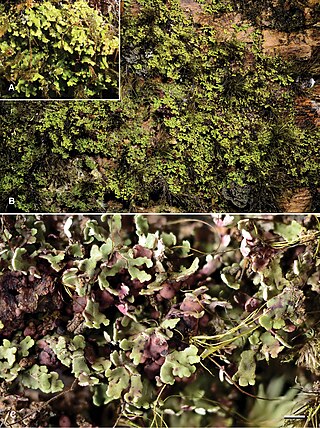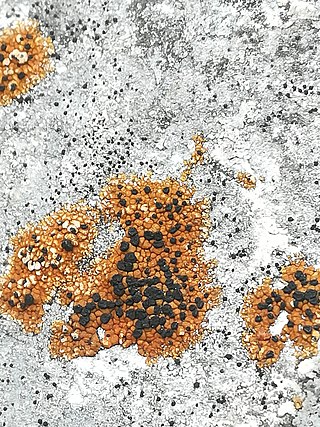Coppinsia is a genus of lichenized fungi in the family Trapeliaceae. This is a monotypic genus, containing the single species Coppinsia minutissima.
Lueckingia is a genus in the family Ramalinaceae. It is a monotypic genus, containing the single corticolous lichen species Lueckingia polyspora. The genus and species were described as new to science in 2006. The species, known only from Costa Rica, was originally found growing on bark in the shaded understory of a lowland rainforest. The genus name honours German lichenologist Robert Lücking (b.1964), who organized the field trip that resulted in the discovery of the new species.

Krogia is a genus of corticolous lichens in the family Ramalinaceae. It occurs in tropical humid forests and rainforests. The genus was circumscribed by Norwegian lichenologist Einar Timdal in 2002, with Krogia coralloides assigned as the type species.

Toninia is a genus of lichen-forming fungi in the family Ramalinaceae.
Josefpoeltia is a genus of lichen-forming fungi in the family Teloschistaceae. It has three species. The genus was circumscribed in 1997 by lichenologists Sergey Kondratyuk and Ingvar Kärnefelt, with J. boliviensis assigned as the type species. The genus name honours lichenologist Josef Poelt, (1924-1995) who was a German-Austrian botanist and was Professor of Systematic Botany at the Free University of Berlin in 1965.
Combea is a genus of lichens in the family Opegraphaceae. It has two species. The genus was circumscribed by Italian botanist Giuseppe De Notaris in 1846.
Minksia is a genus of lichen-forming fungi of uncertain familial placement in the order Arthoniales. The genus was circumscribed by Swiss lichenologist Johannes Müller Argoviensis in 1882 with Minksia caesiella assigned as the type species.
Ingaderia is a genus of lichen-forming fungi in the family Opegraphaceae. The genus was circumscribed by British botanist Otto Vernon Darbishire in 1897.
Caprettia is a genus of lichenized fungi in the family Monoblastiaceae. The genus was circumscribed by Augusto Chaves Batista and Heraldo da Silva Maia in 1965, with Caprettia amazonensis assigned as the type species.
Clauzadella is a genus of fungi in the family Verrucariaceae. A monotypic genus, it contains the single species Clauzadella gordensis, discovered in France and described as new to science in 1996 by Pere Navarro-Rosinés and Claude Roux.
Oevstedalia is a genus of fungi of uncertain placement in the subphylum Pezizomycotina. This is a monotypic genus, containing the single lichen species Oevstedalia antarctica. The genus was circumscribed by Damien Ertz and Paul Diederich in 2004. Previously classified in the Dothideomycetes, Oevstedalia was moved to Pezizomycotina incertae sedis due to the lack of DNA data available for the genus.
Clauzadeana is a genus of lichen-forming fungi in the family Lecanoraceae. The genus was circumscribed in 1984 by Claude Roux, with the crustose species C. instratula assigned as the type.
Sagema is a fungal genus in the family Lecanoraceae. It is a monotypic genus, containing a single species, the crustose lichen Sagema potentillae, found in Nepal. Both the genus and species were described in 1993 by lichenologists Josef Poelt and Martin Grube.
Poeltiaria is a genus of lichen-forming fungi in the family Lecideaceae. It was circumscribed in 1984 by lichenologist Hannes Hertel, with Poeltiaria turgescens assigned as the type species.
Maronea is a genus of lichenized fungi in the family Fuscideaceae.

Brigantiaea is a genus of lichen-forming fungi in the family Brigantiaeaceae. It was circumscribed by Italian botanist Vittore Benedetto Antonio Trevisan de Saint-Léon in 1853.
Gregorella is a genus of lichenized fungi in the family Arctomiaceae. This is a monotypic genus, containing the single species Gregorella humida.

Phoebus is a fungal genus of previously uncertain familial placement in the order Arthoniales, now placed in the family Lecanographaceae thanks to molecular analyses. It contains only one species, Phoebus hydrophobius, found in the Ozarks of the central United States, and described as new to science in 2007.
Vezdaea is a genus of crustose lichens in the monotypic family Vezdaeaceae, which itself is the only taxon in the order Vezdaeales. The genus was circumscribed by Elisabeth Tschermak-Woess and Josef Poelt in 1976. The genus name honours Czech lichenologist Antonín Vězda (1920-2008).
Koerberiaceae is a small family of lichen-forming fungi in the order Peltigerales. It contains 3 genera and 9 species. The family was proposed by Toby Spribille and Lucia Muggia in 2012, after molecular phylogenetic analysis revealed the existence of three lineages of lichen-forming fungi in the suborder Peltigerineae of the order Peltigerales. The lineages represented the genera Steinera, Koerberia, and Vestergrenopsis. The latter genus was later folded into synonymy with Tingiopsidium.



